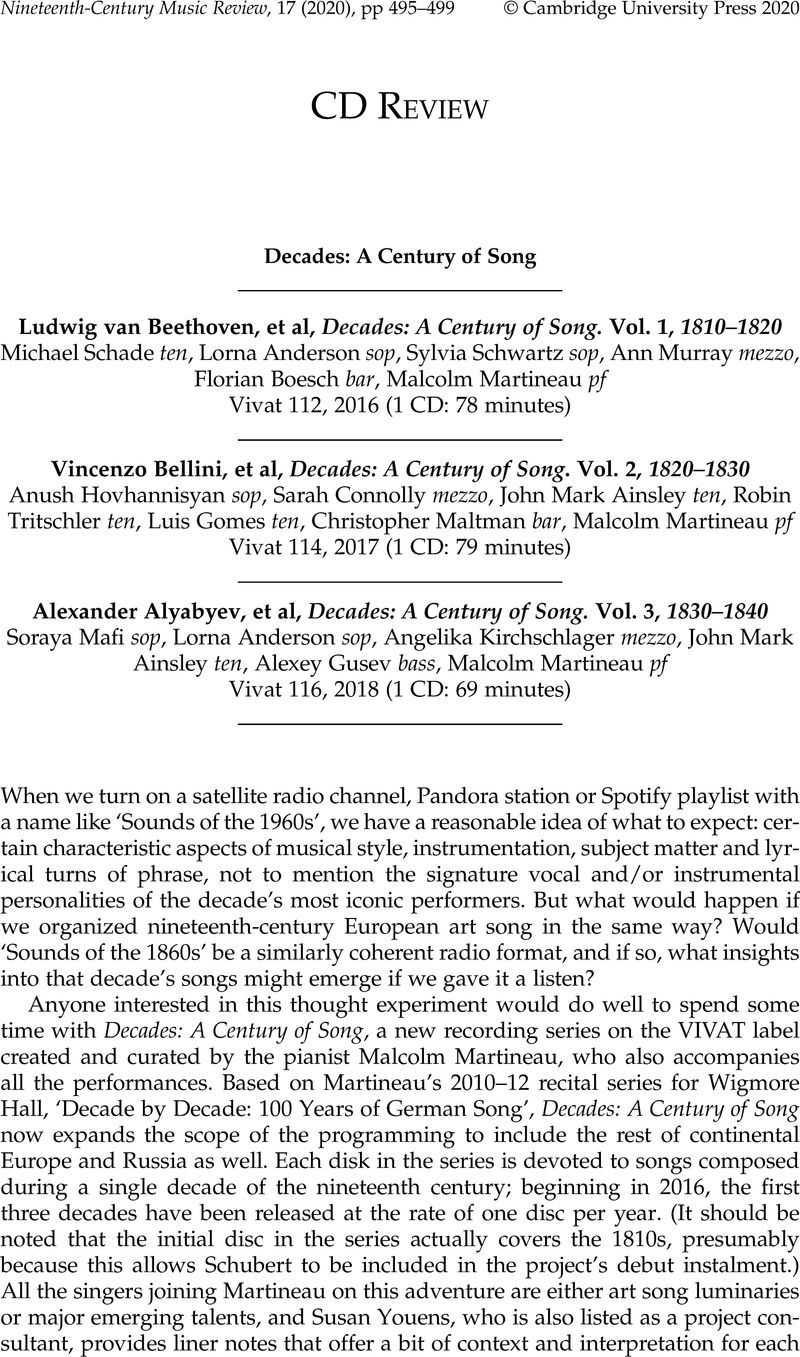No CrossRef data available.
Published online by Cambridge University Press: 08 January 2020

1 Jeffrey, Brian, Introduction to Fernando Sor: Seguidillas for Voice and Piano or Guitar, ed. Jeffrey, Brian (London: TECLA Editions, 1976)Google Scholar, available online at https://tecla.com/fernando-sor/sor-seguidillas-introduction-by-brian-jeffery.
2 For an analysis of ‘Wonne der Wehmut’ along these lines, see Kinderman, William, Beethoven (Oxford: Oxford University Press, 1995): 140–45Google Scholar.
3 The liner notes attribute the text of Bellini's ‘Vanne, o rosa fortunata’ to Metastasio, but there is no evidence I can find to confirm Metastasio's authorship. Instead, the author was almost certainly Davide Bertolotti, a journalist, editor, poet and historical novelist who published the poem under his own name in his magazine Lo spettatore italiano in 1817. See Lo spettatore italiano 8/2 (1817): 70. Bellini resided in Milan in the late 1820s when these ariettas were composed, and he may have met Bertolotti at that time.
4 Méry's dedication can be found in his Poésies Intimes: Mélodies (Paris: Michel Lèvy Frères, 1864): 118. Taglioni had also been the star of the ‘ballet of the nuns’ in Meyerbeer's Robert le diable in 1831.
5 See Weaver, Anne Marie, ‘The Soprano and the Nightingale: Aleksandr Alyabyev's “Solovey”’, Journal of Musicological Research 35/1 (2016): 23–44CrossRefGoogle Scholar.
6 Lewin, David explores both settings along these lines in Studies of Music with Text (Oxford: Oxford University Press, 2006)CrossRefGoogle Scholar; see Chapter 6, ‘Ihr Bild’ (135–52), and Chapter 7, ‘Clara Schumann's Setting of “Ich Stand”’ (153–60).
7 See Frisch, Walter, ‘Schubert's “Nähe des Geliebten” (D. 162): Transformation of the Volkston’, in Schubert: Critical and Analytical Studies, ed. Frisch, Walter (Lincoln: University of Nebraska Press, 1986): 175–99Google Scholar.
8 On Vogl's performance style, see Tassel, Eric van, ‘“Something Utterly New”: Listening to Schubert Lieder. 1: Vogl and the Declamatory Style’, Early Music 25 (1997): 702–14CrossRefGoogle Scholar, and Dürr, Walther, ‘Schubert and Johann Michael Vogl: A Reappraisal’, 19th-Century Music 3/2 (1979): 126–40CrossRefGoogle Scholar.
9 Brigitte Fassbaender and Cord Garben, Carl Loewe: Lieder; Frauenliebe op. 60, Deutsche Grammophon 445575-2, 1988. For a recent account of Loewe's performance practices as a singer, see Chapter 3 (‘Carl Loewe's Performative Romanticism’) of Gooley's, Dana Fantasies of Improvisation: Free Playing in Nineteenth-Century Music (Oxford: Oxford University Press, 2018), 116–53CrossRefGoogle Scholar.